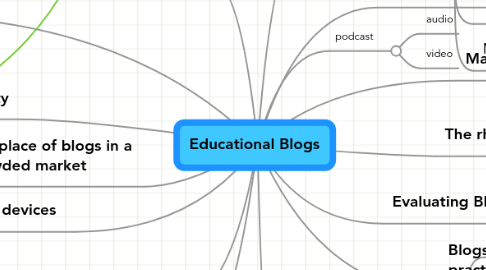Educational Blogs
by theo kuechel


1. Time management issues
1.1. For blog creators
1.2. For blog readers
2. Activity
2.1. Writing Blogs
2.1.1. New Node
2.2. Reading Blogs
2.3. Commenting
2.4. Adding to RSS feeds
3. Blogging Platforms
3.1. MicroBlogging
3.1.1. Twitter
3.2. Instant Blogging
3.2.1. Posterous
3.3. New node
4. The place of blogs in a crowded market
4.1. Microblogging
4.2. Combining Twitter with a blog post
5. As a professional development activity
5.1. A space for reflection
5.2. As a preparation space
5.3. The need for anonymity
6. Blogs as publishing devices
7. Blogs as rants
8. podcast
8.1. audio
8.2. video
9. Other Education Professional
9.1. Advice
9.2. Organisational
10. Example Blogs
10.1. Teacher
10.1.1. Reflective
10.1.2. Practice based
10.1.3. Subject Based
10.2. Pupil Blogs
10.2.1. Primary
10.2.2. Secondary
10.3. Technical
10.4. Media
11. Evaluating Blogs
11.1. Benefits
11.1.1. New node
11.1.2. New node
11.2. Drawbacks
11.2.1. New node
11.2.2. New node
11.2.2.1. New node
11.3. Considerations
12. Technical Issues
12.1. Cost
12.2. Filtering
12.2.1. Block
12.2.2. Moderate Comments
12.3. Platform
12.3.1. OSS
12.3.1.1. Wordpress
12.3.1.2. Edublogs (Wordpress)
12.3.2. Free
12.3.2.1. Blogger
12.3.3. Paid
12.3.3.1. Typepad
